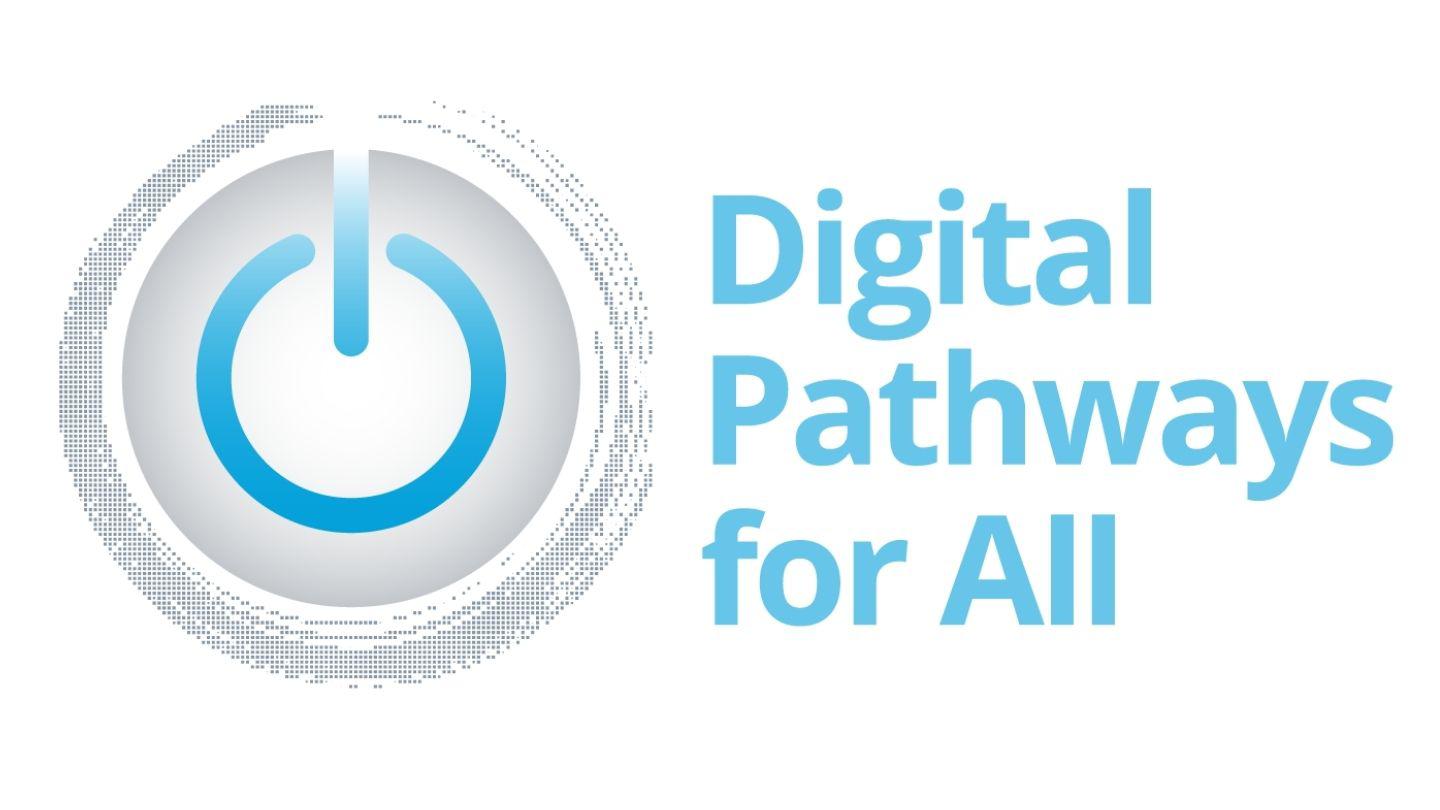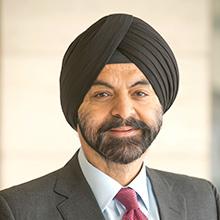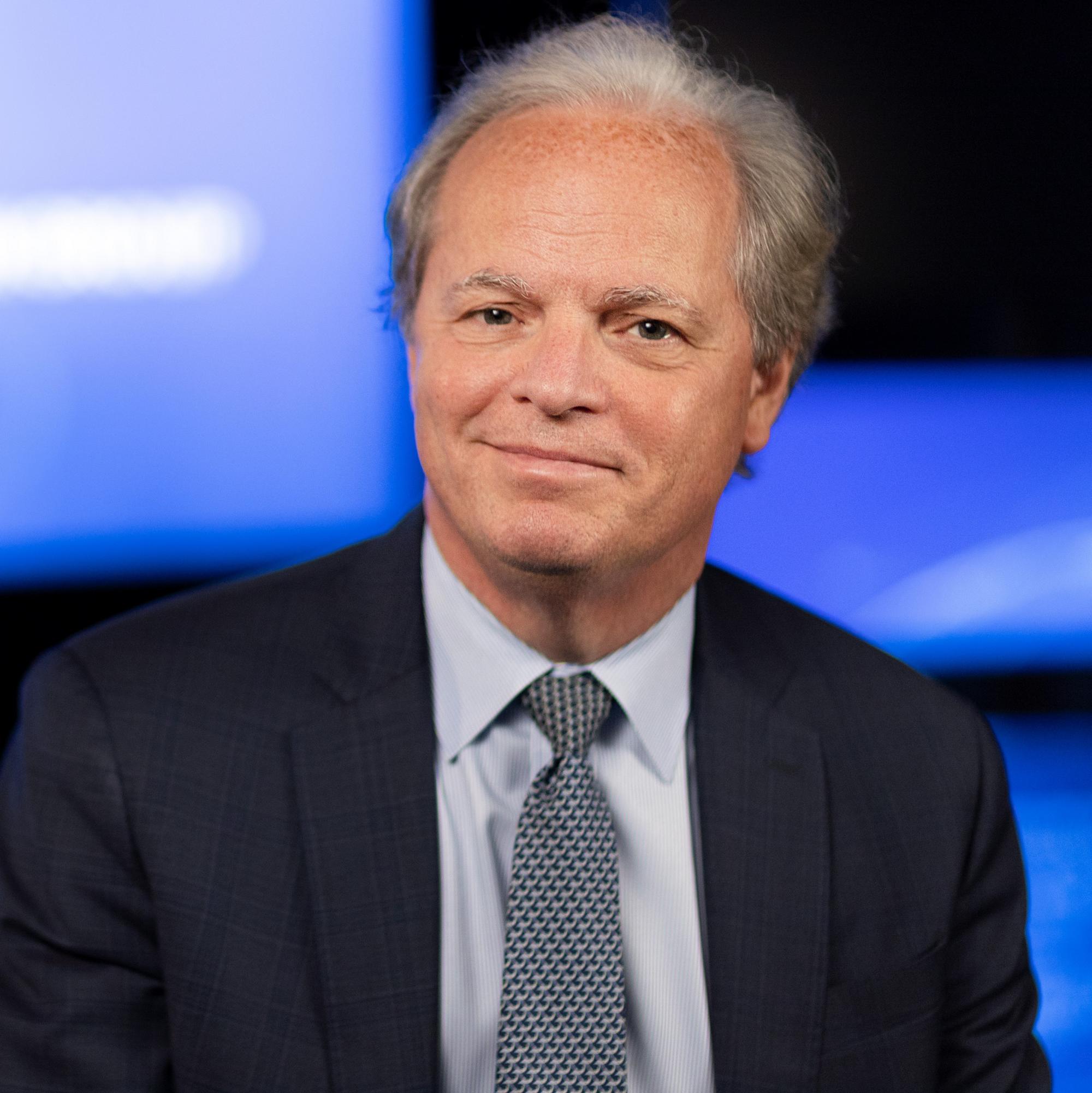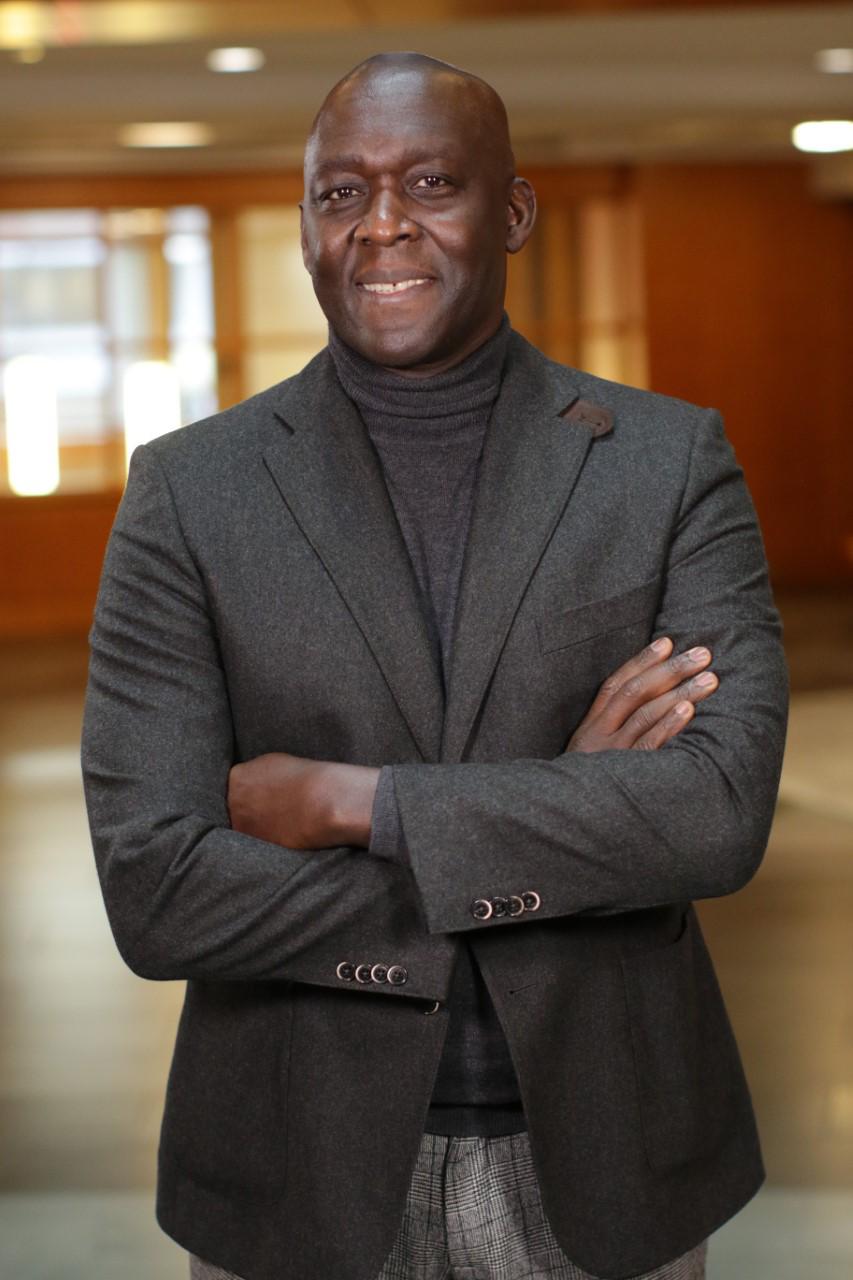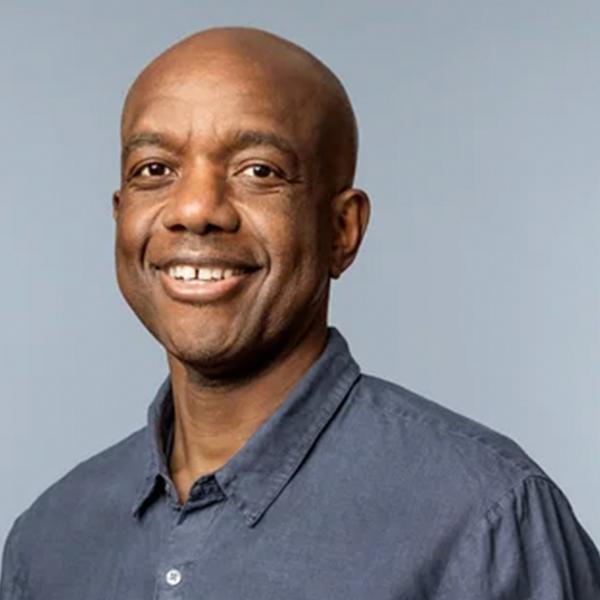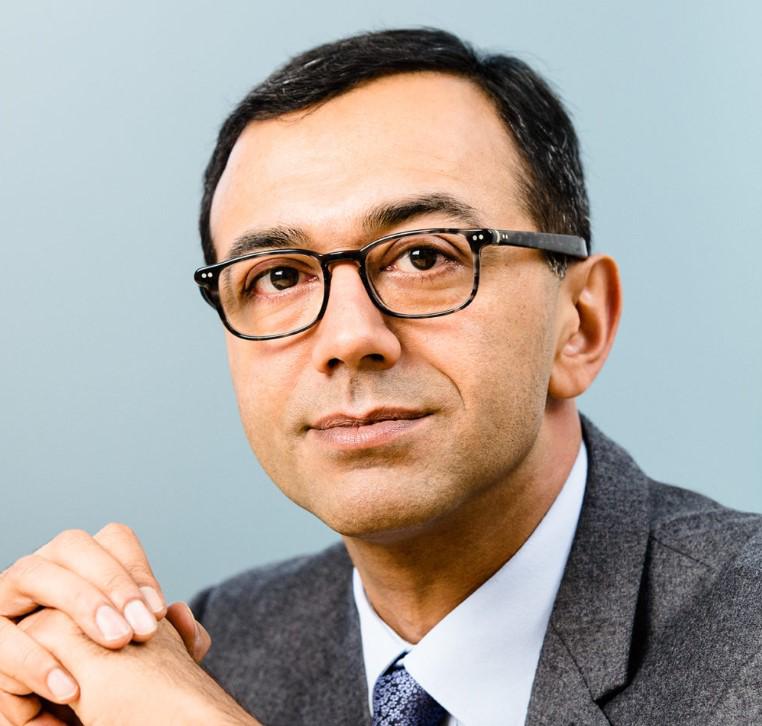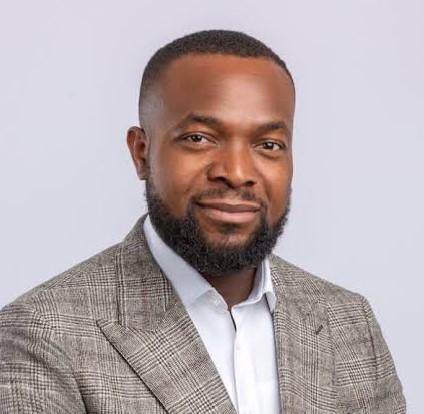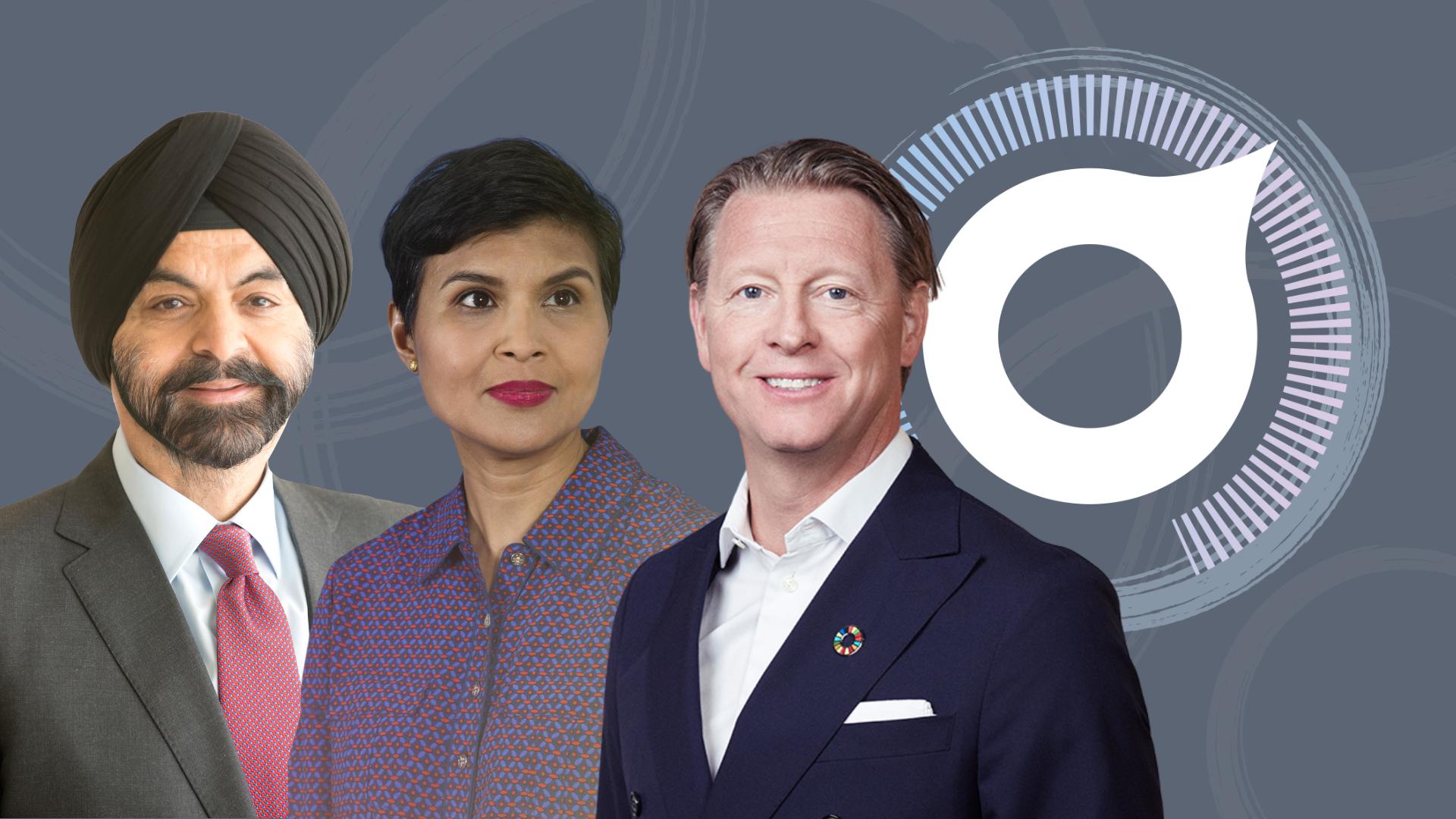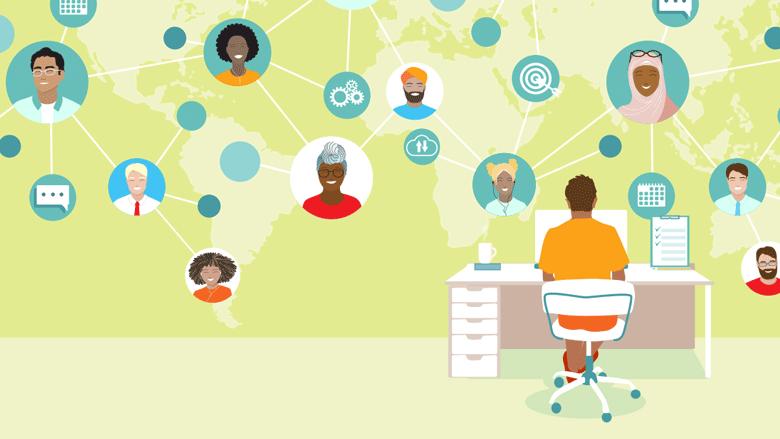[Niala Boodhoo]
We hear so many superlatives when it comes to AI, and I mean that in every way, both positive and negative. What’s clear is that artificial intelligence has the potential to revolutionize our world, especially when it comes to development; but the big question is how do we not repeat the mistakes that led to the current digital divide, especially when it comes to AI? I feel like I would be remiss if I didn’t run this intro through Gemini to see what I missed. Gemini reminded me to say that we’re moving beyond the theoretical into the deeply practical when it comes to generative AI adoption. Also, added this, “With this rapid advancement comes crucial questions about governance, risk, and ethical implications of this technology.” As the World Bank itself has said in its inaugural Digital Trends and Progress Report, this calls for a new playbook and a new level of cooperation between stakeholders, like policymakers, and the private sector, which is why I’m so delighted to have this conversation with the President of the World Bank, Ajay Banga, and Google’s Senior Vice President of Research, Labs, Technology, and Society, James Manyika. Welcome.
[James Manyika] Thank you for having us.
[Ajay Banga] Thank you.
[Niala Boodhoo] Ajay, let’s start with last year, the World Bank announced the launch of a new digital vertical. Can you just give us an update on where you all are with that and how this fits into the Bank’s overall mission and vision?
[Ajay Banga] Yeah, sure. First of all, I’m glad you’re all here. This is our second effort to get a summit like this going. I hope it gets better and better. Sangbu, who’s sitting right here, whom you probably saw in the first session of the opening, is head of that digital vertical. The idea of creating a separate digital vertical was to not say that digital is not an important part of human capital, or prosperity, or development of infrastructure, it is. But if it gets lost in each of those, it doesn’t get to be seen in this quality and attention that it deserves, given the outsized implications it has for each and every aspect of development. That’s the reason to pull it out separately. We’re beginning to make progress on what it should be doing for us. Not only should it focus on the creation of digital public infrastructure in countries so that they can use that to use the private sector and allow it to build on that DPI to enable the reach of digital services into the system. As we know, digital is the one that breaks down barriers to entry. It’s the one that takes away the advantage of incumbency. It does a lot of good stuff to enable things to spread. The idea is to use that DPI and then allow the private sector to build on it to make things possible. That’s one part of what he’s trying to do. The other part of what he’s trying to do is more germane to today’s discussion, which is how do we help get AI to become embedded in countries in the emerging markets? How do we help them meet the challenges of using it, of not getting left behind, of creating the right governance and the right rules and the right systems around it. Those are the two main work streams that Sangbu and his team are focused on. The thing at the back of all this, and I’ve known James for a few years, so he can speak to this more eloquently than I can, but where I’m coming from, this is not about how we use it internally. That’s important, but it’s all about how this gets used in our clients. I guess on the positive side of that, I see enormous pluses with this in health and agriculture. You saw the video. We’re all here because we believe in the pluses. So, repeating those is not going to be value-added to you guys. The issue really is, do we have the right skills in infrastructure in these countries to enable that to happen? Then on the other side, there is the issue of governance and transparency and data protection and regulations. A friend of mine once said to me that this thing is so important that not regulating it would be a big error, but also not regulating it in the best possible way would be an even bigger error. I get that, and I’m trying to figure out what’s the best way of dealing with this as we go forward. The difference between this and prior innovations and systems is the speed at which it’s happening. I don’t think you have the luxury of saying, “We’ve got a decade to figure this out,” because a decade in AI terms is the equivalent of 50 years or whatever in normal terms. That’s the issue that we’re trying to figure our way through.
[Niala Boodhoo] Yeah. Can you want to comment on the speed a little bit, James, and also just what you have seen and what you want this crowd to know about the advancements that you’ve seen with AI?
[James Manyika] Yeah. Thank you for the question. I did my PhD in AI and robotics almost 30 years ago, and I never could have imagined the progress that we’ve seen in the last decade, especially. You mentioned Gemini. Maybe in terms to illustrate the pace and the progress, I’ll mention a few things. First, the models are much better. They’re more capable, they’re more natively multimodal, which means they can work with any content of any kind, not just text and so forth. They’re starting to be able to reason and think these thinking models that allow to do deep research. They’re also becoming what’s called a GenTech, which means it’s more than just inputting things and getting outputs out. They can actually take actions on your behalf. They can be connected to other tools. So, the models are getting extraordinary better. It’s also worth mentioning on the models that we’ve seen, especially recently, that open models are also becoming increasingly capable, which is extraordinary, which opens up a whole set of other opportunities that I’m sure we’ll come back to. The second thing I’d also highlight about the pace of progress is because AI is a general-purpose technology, it’s starting to impact other adjacent technologies. Take, for example, robotics. Robotics is going to have massive acceleration. We’re already seeing that today in our models. I live in San Francisco, and as Google, we introduced our Waymo, driverless cars. If you live in San Francisco or LA or Phoenix, you’re probably riding these cars. In fact, a couple of weeks ago, we reached a milestone where in those three cities, we’re doing something like 200,000 paid rides in those cities, people using driverless cars safely in the city. This is becoming every day, 200,000 rides a week. So, if you come to San Francisco next time, Ajay, we’ll have to take you on a ride. I’m sure those of you who’ve been in San Francisco have been on this Waymo driverless cars. So, the pace is--
[Ajay Banga] I went around in a Waymo car inside your campus years ago, and I must confess it was the early days, and I was scared out of my mind. But that was a long time ago.
[James Manyika] Well, so it’s taken It’s been a very long time. So, the driverless car project at Google has been going for almost 15 years.
[Niala Boodhoo] I was going to say, when were you…? When did you take that ride?
[Ajay Banga] When I was still at MasterCard. It’s got to be pre-COVID, so 2019 or something with Sundar [Pichai]. When we went into this car, and both of us looked petrified out of our minds, and it was fine after that.
[James Manyika] Well, actually, Sundar tells the story of how he took his parents on a driver’s car ride last year. So, these have become quite real. Let me mention one other thing on pace of progress. I think one of the things that’s underappreciated is how in the last couple of years, especially, these models have become a lot more efficient, both in terms of the computer required or even the energy requirements. We’re starting to see huge gains in efficiency. I think all of this is fundamentally important. But I think where it matters, certainly for the purpose of this conversation here, is where we see the potential impacts and benefits. Here, I think we’re going to see those benefits in, I would say, three or four areas. First, how this actually benefits individuals who want access to information, be able to use these tools to help themselves with their own productivity and activities and so forth. That’s one. The second is how this technology could actually power economies everywhere. As we said, in economic terms, this is one of those once in a long time a general-purpose technology where every part of economic activity from small and medium-sized businesses to large companies to the public sector, and all of that will start to use this technology.
The economic potential is significant. The third area where we’re going to see the impact, and we’re already seeing it, is how this technology is already advancing scientific progress. I’ll say something about that. Then, of course, this technology is starting to help us address some large global pressing challenges in society. But let me say one more quick thing about the scientific progress, because recently my colleagues won a Nobel Prize for some of their work using AI to actually advance some long-standing, almost like a 70-year grand challenge in biology, which is how to understand the structure of proteins, which was an incredible challenge because proteins are the workhorses of all of biology, all of it. If you want to understand diseases, discover drug therapies, vaccines, you have to understand how proteins work. What they were able to do was, before they did what they did, I think we only understood this structure of something like over just over 100,000 proteins through extraordinary painful lab work that scientists have been doing for decades with techniques like X-ray crystallography and so forth. But the AI algorithm, AlphaFold, was able to discover the structure and predict the structure of all the proteins known to science, all 200 million of them. We actually made that data set openly available. So, today we’ve had something close to about just over two and a half million biologists around the world in 190 countries accessing these data sets to be able to do their work and research, which allows you to tackle neglected diseases and so on. And you can go on to other areas of science, whether it’s in in physics, material science, and so forth, and even helping to tackle challenges like floods and wildfires. In fact, one of the things we’re very proud of is that we now are able to use AI techniques to predict floods with enough advanced notice. Because what you need to be able to predict floods with something like five or six or seven days.
[Niala Boodhoo] And wildfires as well.
[James Manyika] I’ll come back to wildfires. But the flood forecast, the reason why the flood forecast and the wildfires are important is they become quite real. So, what began as an initial experiment we did in Bangladesh, and it worked. We now cover something like over 100 countries with more than 700 million people in those countries with flood predictions. You mentioned wildfires. We’re now covering about 27 countries with wildfire predictions for boundaries. In fact, just two days ago, I don’t know if you saw this, we launched the next part of that project, which is these new satellites that we launched two days ago. It’s the first of a constellation of what will be 53 satellites that will allow us to observe, if you like, before these satellites, what you could only observe was something like areas of about 25-by-25 meters and make predictions about that. With these new FireSat satellites that we launched the first ones a couple of days ago, we’ll be able to observe about five-by-five meters and make wildfire predictions. This is going to be quite transformational. You can see all these areas where this technology is starting to be extraordinary helpful.
[Niala Boodhoo] Mm-hmm. I want to get back to some of those technologies, and Ajay, you also talked about skills. But before we get to the job skills, can I just go back to the idea of this AI divide and ask you how the Bank is equipping countries to help overcome this?
[Ajay Banga] Look, I think that what AI needs to work well for a country are four things, and four principal things, a very basic level. The first is computing power, lots of it. The second is electricity, lots of it, although more efficient now than earlier, but it's still a heck of a lot more than we currently had planned for. Third is data, more of it, better than less of it, because it improves the predictive power of that data and to adapt it to your circumstances; but also, that data needs to be kept in its simplest form because that enables the most manipulation off the data, and then you need that data to be kept safe and secure in a way that protects privacy. There’s a lot of ifs and buts inside that data. Then, the fourth element of this is the people who understand how to use that. That’s the skills part I was referring to. None of this works without the right kind of access to the internet as well, because otherwise, people using it for their own purposes, as James was just describing, doesn’t happen without access to the internet. And internet doesn’t happen without access to electricity. So, there’s a bunch of things we can do. We’ve launched this thing of reaching 300 million people in Africa with electricity. I’m not talking about two solar lanterns in a room. I’m talking about the productive use of electricity at tier three levels, so they can get computers and televisions and the access to the internet and a chance to be a productive part of their society. That kind of effort, to me, is foundational to enable this infrastructure and skills to begin to get built. I worry about it because I think of two things that happen if you don’t do it well. One is a lot of the emerging markets are subscale in their absolute size. Unless they are willing to collaborate across a number of markets, they will never get to the right scale or size that allow companies or others to get them to be the right cost-value dynamic. The second is because data, it goes through cycles of being viewed as a national security resource. You got to be careful where that data goes and who’s touching it. I think that makes people like Google and others very careful about how they deal with that data. They put enormous rules in place to try and ensure it’s managed well, but this stuff is evolving very quickly. I think being ahead of this game is very important. Then the third thing I’d say, which is more worrisome to me in a different form, is that the economics of development over the last 30, 40 years of creating jobs have been to move through global trade to really move manufacturing to a different location. In the old days, trade was about who had the minerals, or gold, or spices, and then who could manage the logistics of getting ships to come and go safely on the high seas. Then, it became that plus the arbitrage of labor cost. Logistics, resources, plus the arbitrage of labor. Then, resources were moved around in some production cycles 10 times to complete a product. The thing is now with AI, I’m not sure that labor arbitrage will remain as much of a positive in the trading systems. I think you’re going to get a change in the way trade works, aside from the global trade versus more and more bilateral and regional deals that you are seeing happen already. Aside from the geopolitics, I think there is this fundamental economic underlying factor which is going to change, which is the arbitrage that labor cost brought, because AI will change that. I think there’s three or four things going on here, not all of which we have the answers to. We’re finding our way through it as well, but I know I’m very focused on, can we help build the infrastructure and the skills for these countries? Second, can we be a good impartial convener of the ability to come to conclusions on the right guardrails around regulations and ethics and data privacy and the like. I don’t know that yet either. It’s early days for us in that space, but those are the two things we think we can be helpful with.
[James Manyika] Yeah, I would agree with that, Ajay. Let me elaborate at least the way we see it. I think because this technology represents such extraordinary opportunities of the different kinds that I was describing earlier, it’s also important to make sure that everybody can benefit from it. So that’s why you want to tackle these divides that we’re talking about. In our minds, at least, while there’s extraordinary opportunities for development, all countries, both developed and developing. I see a few particular challenges for developing countries.
[Niala Boodhoo] That’s what I wanted to ask you about, particularly. What do you want this crowd to know about the challenges you’re seeing in the difference between developed and developing economies?
[James Manyika] Well, first of all, it’s worth keeping in mind that, as I said, the opportunities are economic, scientific, pressing societal challenges, healthcare, education. Think about transforming sectors that matter. Think about the delivery of public services by governments to their citizens. All of these are areas that can be transformed by this technology, but none of those gains or opportunities are automatic or even guaranteed. That’s as true for developed as it is for developing countries, but the particular challenges that I see, for example, in developing countries, I think of several kinds. Let me try to enumerate them. First, as Ajay just pointed out, there’s access to what I think of the ingredients for AI. That’s access to compute, access to data, creating data, but even access to the models themselves. That’s fundamentally important. You’ve got those challenges. Then you’ve got some of the basic infrastructure challenges. As Ajay pointed out, that’s both digital infrastructure, but even basic electricity and connectivity is also an important challenge. That’s why I was glad Doreen was highlighting some of the connectivity and broadband challenges in the earlier discussion. Third, I think there’s an enormous amount of talent, skill challenges that are going to be very important. Those are both the people who’ve got the training experience, expertise to be able to capitalize on this technology. Then, also skilling that’s required for workers who are going to work alongside this technology. That’s an important challenge. There’s also a fourth challenge that often gets left out, which is the creation of vibrant ecosystems. I think what’s going to be very important in developing countries is that there are entrepreneurs, innovators, researchers who are developing applications for their communities and their countries in order to transform and create both, business and societal opportunities. The emergence of vibrant ecosystems, I think, is a real challenge. That’s also, by the way, that’s a challenge both for developed economies, but also especially for developing countries. We’ve been glad that we’ve been involved in helping to create some of these ecosystems in places like Ghana and Nigeria, but also places like Brazil and other places. That’s important. Let me mention one final thing. I think this came up in the previous discussion. I think it’s going to be quite important to have what I think of as enabling policy, policy that is focused not just on addressing the complexities and risks, but also enabling the innovation that’s needed to fully capitalize on this technology, because the opportunities, especially many of them that are in the public interest are not going to happen by themselves. Unless policymakers are also focusing on enabling policy, I think Ajay’s comment was correct, which is policy should also enable the kinds of opportunities and innovation that are going to benefit societies. I think developing countries in particular have faced these particular challenges.
[Ajay Banga] I think there’s an important point there, which is, if you get ahead of yourself with the policies, you could stifle the growth of this innovation. If you’re too far behind, you will end up with enormous challenges in reining in what could have then left the stable. But if you’re able to follow quickly, meaning your innovation follows, or rather policies or regulations follow innovation quickly, nimbly, then I think we’re in the right place. Enabling regulatory sandboxes to experiment with these ideas, things like that are going to be very important for private sector and development and public institutions to work together, to get the guardrails to work well for this thing.
[James Manyika] I would also add that because these challenges are so enormous, it’s the reason we’ve been making investments to try to partner with countries both in the developed world here in the US, but also in developing countries. For example, we’re spending an enormous amount of time investing and trying to improve access to languages, for example, because this technology enables that, in fact--
[Niala Boodhoo] We need the data.
[James Manyika] We need the data, but already we’re making progress. Today, for example, Google Translate now can translate 250 languages. We added 110 just in the last year. In fact, our goal is to get to a thousand languages. When it comes to infrastructure, we’ve been building data center infrastructure in a variety of countries, whether it’s in Latin America, or in Africa, or in Asia. We’ve also tried investing in cable and broadband connectivity in different countries. When it comes to skills, for example, just in the last several years, we’ve now trained over 100 million people in digital skills. In fact, last year, we announced, for example, a new additional commitment to spend another 120 million dollars in skilling. We’re trying to do our part, but I think there’s an enormous challenge and things that are going to need to happen if developing countries are going to fully benefit from this.
[Niala Boodhoo] Let’s talk about those skills because you mentioned that at the beginning, Ajay, it was your principles. I was struck by this one data point. 60% of employment in the United States in 2018 was attributed to job titles that did not exist in 1940. I just want to ask you, I know in your upcoming Spring Meetings, jobs is going to be a huge priority and point of discussion. How does, as we’re seeing economy slow down, as we’re worrying about jobs, how does that fit into what we’re talking about here?
[Ajay Banga] Look, there’s a whole other angle here, which is if you take the steps back, why am I focusing on jobs? The reason I’m focusing on jobs as the outcome of development as compared to the input of schools and healthcare clinics being what we are focused on, trying to move from the input to the output, is because I think all our eyes need to be focused on the opportunity of the demographic bulge that’s coming through the emerging economies in the coming 15 years. In the emerging markets, 1.2 billion young people are going to become eligible for a job in terms of their age in the coming 12 to 15 years. Current forecasts are that the same countries will produce about 400 million jobs. Now, those forecasts are by economists like me, and we could be notoriously wrong, but we would not be wrong by 500% or 300%. Instead of 400, it might be 600 million jobs or 200 million. The problem is there’s 1.2 billion young people coming through that pipe. If young people do get a job, whether it’s as an entrepreneur, or working for a small business, or working on a small farm, or for a medium-sized business, or whatever, then they are productive, they have hope, they have optimism, and that creates markets for people like Google, but if they don’t get a job, then the downsides are quite severe. We know about local social unrest, but the biggest problem to me is irregular illegal migration, which puts the people at risk but also damages all the societies where that illegal migration ends up. I think if you’re not careful, we run a very severe risk in the coming 15 to 20 years of allowing this demographic bulge to go from a dividend to a liability. To do that well, we need to start thinking about these people. The way we are focused on it is there are five areas where jobs will get created in a place like Africa, for example. The first one is in infrastructure. We talked a little bit about electricity and digital, but I’m talking about bridges, roads, airports, agricultural warehouses, railways, that. The second is in making agriculture, smallholder farmers viable and a business in themselves so that every young child of a smallholder farmer does not feel that their future is better in an urban area trying to find a job, which today is the model in a lot of countries. We’ve got to change that to enable these smallholder farmers to feel that this is somewhere they can be. That’s why we made a commitment to spend 9 billion a year on getting smallholder farmers through cooperatives, and technology, and AI, and better fertilizer, better farming techniques. Again, he can talk about this better than I can.
[Niala Boodhoo] Which would change migration patterns as you’re talking about as well.
[Ajay Banga] Also, internally as well as to other places. Third is delivery of primary health care, not just because people will become healthier. Of course, that’s important, but because you will employ nurses and medical diagnostic technicians and PPE manufacturers, not just doctors. When you do that, you create the kind of ladder of jobs that every country and every society needs. We’ve committed to reach 1.5 billion people with primary health care by 2030. You can begin to see a method to our madness of commitment, reach for electricity, reach for agri-business, reach for primary health care. The fourth category where things will be very important will be in manufacturing for local consumption for these bilateral and regional trade deals, but manufacturing with jobs being created where the model is not outsourcing a Western job to this country, but locally relevant manufacturing. Minerals and metals. Africa has more minerals and metals for the energy transition, which we will all need, but if all we do is extract the mineral and bring it to our country and process it here, we don’t create enough jobs there. That’s a different model of job creation. The fifth one is tourism. Tourism enabled by skilled institutes as part of the infrastructure. Whether you do this through companies or entrepreneurs, you’re going to need these five. If you look at these five, they will all be impacted by AI over the coming decade, but they will not only be impacted negatively, they will also be impacted positively. Tourism can improve with AI by generating the right ideas and methods of targeting and creating individualized itineraries for the right people. Just one example, and so on and so forth. His healthcare example. I could keep going, but that’s the idea.
[Niala Boodhoo] Yeah. Can I ask you about that? Because there is experimental evidence that generative AI can actually boost labor productivity and expand job opportunities, especially for lower-skilled or less experienced workers. Can you talk about how you’re seeing that, especially as we were just mentioning different agriculture or other programs you wanted to highlight?
[James Manyika] Yes, absolutely. There’s now a lot of recent empirical experimental evidence coming out of studies that has been now been done by several economists. I think actually one of them, David Otter is going to be here later today speaking about this. It basically shows that in many occupation types, when workers are using generative AI technologies assistively, it actually lowers the barriers through of expertise and experience. In fact, less skilled workers are actually able to perform at a high level of productivity. I think that actually reduces barriers, not just to jobs and opportunities, but for those workers. But it also increases their productive output in ways that contributes to productivity. I think this is fundamentally important. Now, these are still early studies. We should keep watching and doing the research on this, but I want to bring it back also to what Ajay was talking about, which is areas like healthcare and agriculture. It’s actually quite striking that in many places in the developing world, often there’s not enough primary care. In fact, the use of these technologies assistively can expand the number of people who can actually provide primary care. We’ve seen this in a few examples. For example, in maternal health. We’re using AI technologies in East Africa, for example, that assist less skilled people to be able to provide primary care. It turns out, by the way, that something like 30% to 40% of people in the developing world with TB go undiagnosed. We just done a year-long study in Zambia and also in India, where AI tools were able to do TB diagnostic as well as an expert doctor would. Imagine the technology in the hands of somebody who’s less skilled, still able to provide that primary care. I think that’s extraordinary. The same thing is happening in breast cancer, for example, in areas like diabetic retinopathy, where we’ve now tested something like 600,000 people in the last couple of years. We’ve now partnered with an organization in India, and the goal there is to try to take that primary assistance up to about 6 million people. So, this assistive use of technology, not only A, delivers primary health care as an example, but also provides employment for those people with less skills who are now able to perform those functions, especially in places where the availability of primary care physicians is severely limited, but I want to say something else about the question of jobs.
I think whether we’re talking about developed economies or developing economies, much of the research now suggests that what we will see are three effects. One is, I think it is important to say this, that there will be some occupations that will decline over time because the constituent activities and tasks are going to decline. But at the same time, we are going to see some jobs grow because demand for them is going to go up. But then the larger effect is this idea of jobs changing and being assisted in the ways that we just talked about. I think last year, the International Labor Organization did this enormous study where they looked at something like, I think they covered 140 countries, looking at about 400 occupations. One of the conclusions in that research was that the assistive effect of these technologies was going to be six times the displacement effect. I think that’s important to keep in mind, but they did also highlight something that we all know, which is if the assistive effect is going to be that large, an enormous amount of skilling and capability building is going to be fundamentally important. I think that’s a big part of the work we all have to do.
[Niala Boodhoo] You all have talked about so many things here. I just wanted to highlight three things you said before I ask you both the last question. Ajay, you started by saying it’s all about how AI gets viewed by clients, and that the pace of this, being ahead of the game is important, but that we need policies that are enabling. It sounds like both of you are saying that, but we also need developing countries have particularly a need for the creation of vibrant ecosystems. As we think about all of that, I just wanted to end by asking both of you what you’re most excited about when you’re thinking about the potentials for AI. James, let’s start with you. Ajay, I’ll let you have the last word.
[James Manyika] Oh, there’s so much.
[Niala Boodhoo] There are so many things. Anything we haven’t talked about.
[James Manyika] Well, I’m excited about the societal impacts, both through the advances in science, which are going to benefit everybody, but then also this idea of tackling our most pressing challenges, whether it’s in food shortages, food security, the effects of climate change. I think this technology is going to help us address those things in a huge way, but I’m also excited about how this will actually enable people have access to things. Think about the world’s knowledge. Think about access for education, being able to learn in your own language, being able to get customized training, being able to get personalized contextual learning that’s now possible. I think that’s going to be extraordinary. I’m still amazed by the number of people who come to tools like Google Search or YouTube to learn. Think about how much better that will be when it’s personalized and assisted through AI. To me, I’m a child of... I grew up in Southern Africa. The access to information and education, things that I didn’t have access to, I think is game-changing and it’s life-changing for people. That’s what I’m excited about. But I should say this, Niala, that as excited I am about these possibilities for people, the economy, and science, and all of these things, I don’t think those gains are automatic. I think it’s going to take a lot of investment and focus by not just us, but countries and policymakers to invest to make all of that possible. That’s why I think it’s important to highlight the critical challenges that exist. None of this is going to be automatic. That’s something we all have to work on to make it happen.
[Niala Boodhoo] Ajay?
[Ajay Banga] The only thing I’d add to that is two things. First is I’m really excited about learning how to use ChatGPT to plan my next holiday.
[Niala Boodhoo] That’s good. You asked my fun question. That’s pretty cool. How you’re using AI.
[Ajay Banga] But to the serious part of this, what he just said, think of all that from the lens of young people and this demographic bulge coming through the emerging markets, and think of what he just said can do for those young people. To me, young people are our future. That’s my optimism. That’s what I come to work for, and that’s what I care about. I’ve got grandchildren. I can’t even begin to imagine how their lives will be helped by people like this guy. So, thank you very much. Thank you.
[James Manyika] Thank you for having me. [
Niala Boodhoo] Oh, well, thank you so much. Does there anything... It sounded like you wanted to add something.
[Ajay Banga] Yeah, go ahead. I’ll try to end before you finish.
[James Manyika] No, I guess the other thing I would also just encourage everybody with a lot of these amazing technologies, there’s nothing like personally experiencing them and using them to do useful things for you. So, there are products that I use all the time I’d encourage you just to try these.
[Niala Boodhoo] What do you use all the time?
[James Manyika] Oh, what do I use?
[Niala Boodhoo] Yeah.
[James Manyika] Actually, one of my favorite things is something called NotebookLM that we created. And the reason I find that very useful, it’s actually, quite frankly, a useful way for me to learn. I don’t know if any of you tried it. You can throw in papers you’re trying to read and understand, and I read a lot of technical papers, and then I can engage with those papers with that technology. If I want, I can actually create an audio podcast that I can listen to in my car that summarizes those materials. I can engage with it. It’s accurate. So that’s actually personally very useful.
[Ajay Banga] Oh, man, I got a great idea. I want to take all the papers I get given in the World Bank and put them into that thing and produce English language back to me.
[James Manyika] Yeah, so you can actually—
[Ajay Banga] Perfect.
[Niala Boodhoo] You have endless podcast for you to listen to.
[James Manyika] You can actually put in things in any language. So NotebookLM can actually handle—
[Ajay Banga] No, I’m just kidding.
[James Manyika] No, seriously. It can actually handle about 200 languages. It’s personally very helpful for me.
[Niala Boodhoo] All right. Well, thank you so much, James, Ajay. Thank you for being with us.
[James Manyika] Thank you.
[Applause]


